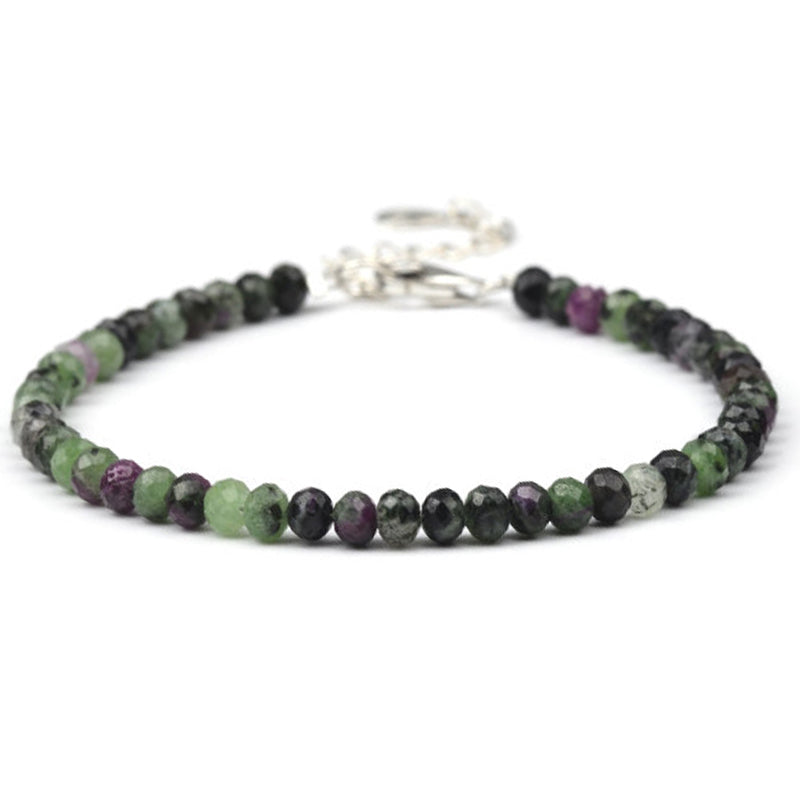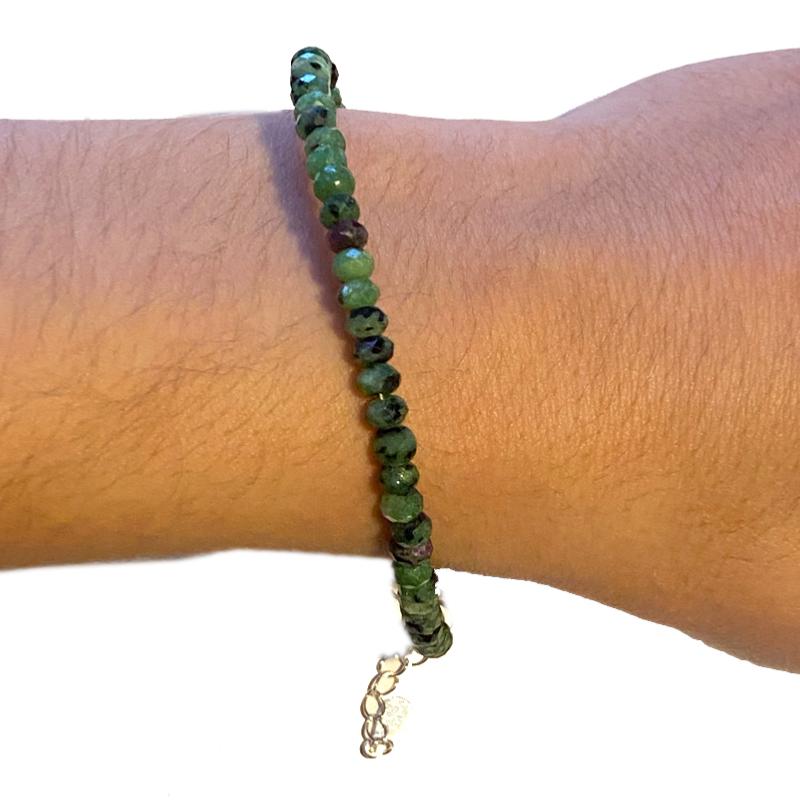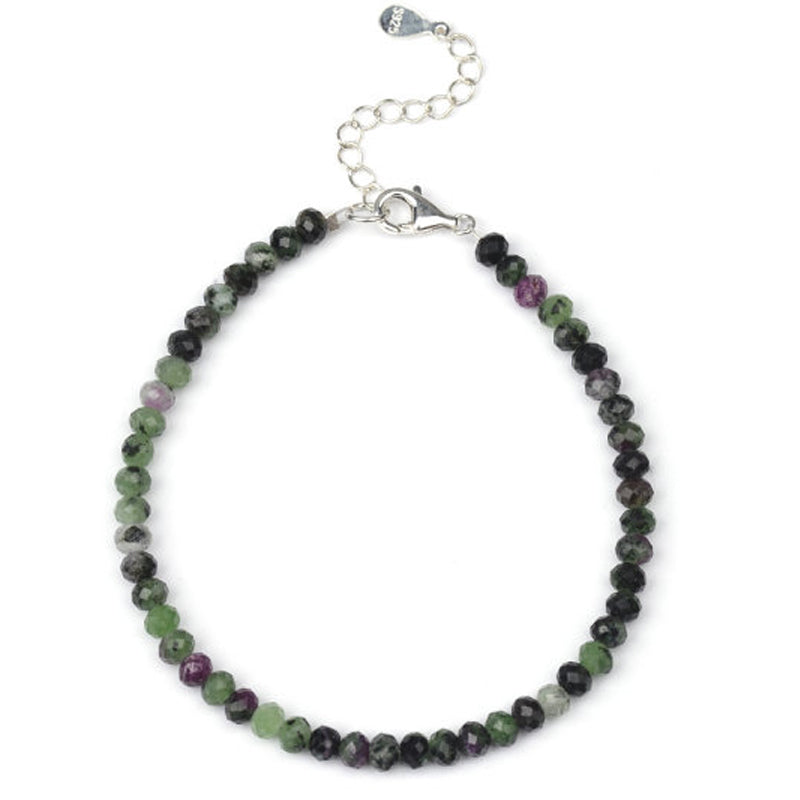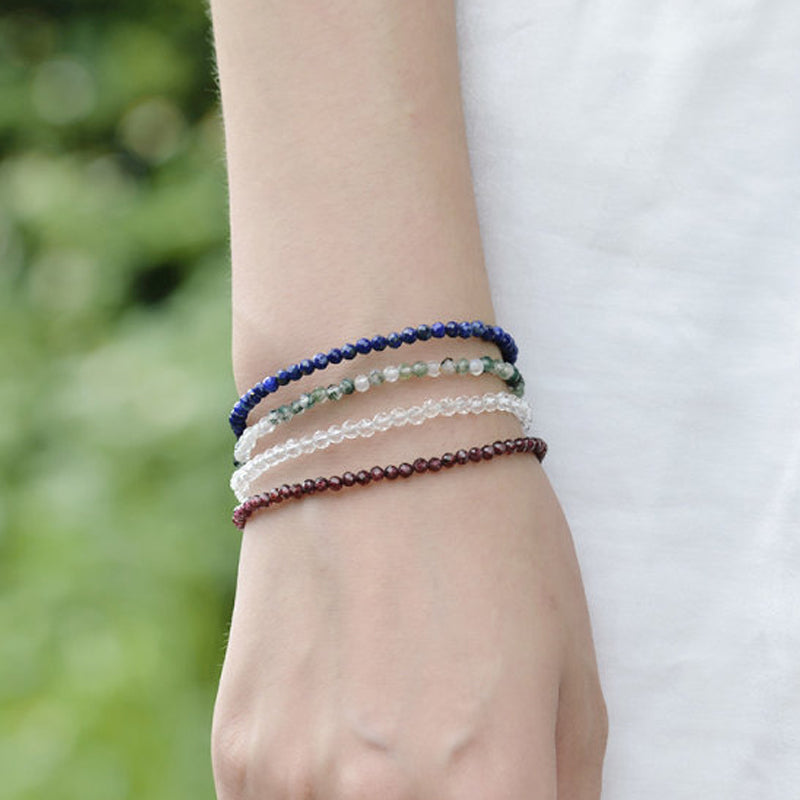1
/
of
5
Ruby bracelet on zoisite faceted beads in 925 silver
BRA-RUBZARG-01
8c984efa-30a8-5524-41cc-ae7b332135e6
028d80eb-2b30-41d4-b221-bda49eca04cf
- Regular price
-
29,90 € - Regular price
-
- Sale price
-
29,90 €
Tax included.
Shipping calculated at checkout.
Couldn't load pickup availability
Learn more
This stunning 925 silver bracelet features faceted ruby-on-zoisite beads, a semi-precious stone renowned for its healing and grounding properties. The uniquely shaped beads add a touch of elegance to your outfit, while the 925 silver provides lasting shine.
BRA-RUBZARG-01
Origin: South Africa
Grade: A
Dimensions:
17 to 21cm
Weight:
About 4g
Very beautiful bracelet made of faceted ruby beads on zoisite of 2-3mm.
Handcuff closure with 925 silver chain allowing the bracelet size to be adjusted from 17 to 21cm.
Zoisite was discovered very recently in the 18th century by the Austrian naturalist and mineralogist Sigmund Zois, Baron Von Edelstein. He sent samples of this stone to the famous German mineralogist, Abraham Gottlob Werner. Werner named this stone zoisite in honor of its discoverer, Sigmund Zois.
The name ruby comes from the Latin "rubeus" meaning red. It is an extremely hard red gemstone, which owes its color to the presence of chromium atoms. The name ruby zoisite comes from the combination of these two natural stones: green zoisite and red ruby. Black spots can also be seen, which are actually inclusions of hornblende, the generic name for a group of silicates.
Ruby in zoisite is sometimes referred to as anyolite. The ruby extracts found in zoisite are mostly low-quality rubies, making its price very affordable.
Ruby zoisite is a mineral with very few myths or legends associated with it. However, in East African oral traditions, the ancients speak of a magical green stone, speckled with black and red. This stone was reputed to bring abundance to hunters and to protect them from various dangers encountered, such as attacks from wild animals or bad weather. Some even believed that this stone had the power to make its wearer invisible.
Ruby has a hardness of 9 on the Mohs scale, and zoisite has a hardness of between 6 and 6.5 on the same scale. Zoisite ruby owes its other name, anyolite, to a large deposit discovered in Tanzania in 1954. Its name is derived from the Maasai word "anyoli," meaning green. It was primarily used for setting jewelry or carving into ornamental or religious objects.
Zoisite is composed of aluminum and calcium silicates, while ruby inclusions are composed of aluminum oxide and belong to the corundum group.
Nowadays, ruby zoisite is mainly used in the manufacture of jewelry (pendants, bracelets, etc.) or lithotherapy objects. Indeed, it is particularly appreciated in lithotherapy due to its mixture of stones with multiple benefits.
The main deposits are located in Tanzania, Australia, India, Mexico, etc.
In lithotherapy, ruby zoisite is a stone that stimulates vitality and provides motivation. It thus gives the strength to accomplish one's projects and achieve one's goals. In fact, this stone allows one to become fully aware of one's abilities to cope with a workload. It encourages its wearer to no longer be influenced by the ideas of others, but to follow their own. Thus, it contributes to social and professional success.
A stone of charisma, it engenders love and admiration from those around you. It restores self-confidence and assurance. It facilitates openness toward others and develops feelings of compassion and empathy. It provokes a genuine interest in others and a desire to help.
This stone is excellent for dealing with the loss of a loved one, a painful divorce, or a job loss. It helps restore serenity and peace. It is a naturally soothing stone that calms nervousness and anxiety. It can energize those lacking energy and soothe those who are overly agitated.
With its blend of green and red, ruby zoisite brings balance between power and justice, authority and submission, strength and gentleness. It is perfect for those with roles related to justice.
Origin:
South Africa
Grade:
A = good
Very beautiful bracelet made of faceted ruby beads on zoisite of 2-3mm.
Handcuff closure with 925 silver chain allowing the bracelet size to be adjusted from 17 to 21cm.
Zoisite was discovered very recently in the 18th century by the Austrian naturalist and mineralogist Sigmund Zois, Baron Von Edelstein. He sent samples of this stone to the famous German mineralogist, Abraham Gottlob Werner. Werner named this stone zoisite in honor of its discoverer, Sigmund Zois.
The name ruby comes from the Latin "rubeus" meaning red. It is an extremely hard red gemstone, which owes its color to the presence of chromium atoms. The name ruby zoisite comes from the combination of these two natural stones: green zoisite and red ruby. Black spots can also be seen, which are actually inclusions of hornblende, the generic name for a group of silicates.
Ruby in zoisite is sometimes referred to as anyolite. The ruby extracts found in zoisite are mostly low-quality rubies, making its price very affordable.
Ruby zoisite is a mineral with very few myths or legends associated with it. However, in East African oral traditions, the ancients speak of a magical green stone, speckled with black and red. This stone was reputed to bring abundance to hunters and to protect them from various dangers encountered, such as attacks from wild animals or bad weather. Some even believed that this stone had the power to make its wearer invisible.
Ruby has a hardness of 9 on the Mohs scale, and zoisite has a hardness of between 6 and 6.5 on the same scale. Zoisite ruby owes its other name, anyolite, to a large deposit discovered in Tanzania in 1954. Its name is derived from the Maasai word "anyoli," meaning green. It was primarily used for setting jewelry or carving into ornamental or religious objects.
Zoisite is composed of aluminum and calcium silicates, while ruby inclusions are composed of aluminum oxide and belong to the corundum group.
Nowadays, ruby zoisite is mainly used in the manufacture of jewelry (pendants, bracelets, etc.) or lithotherapy objects. Indeed, it is particularly appreciated in lithotherapy due to its mixture of stones with multiple benefits.
The main deposits are located in Tanzania, Australia, India, Mexico, etc.
In lithotherapy, ruby zoisite is a stone that stimulates vitality and provides motivation. It thus gives the strength to accomplish one's projects and achieve one's goals. In fact, this stone allows one to become fully aware of one's abilities to cope with a workload. It encourages its wearer to no longer be influenced by the ideas of others, but to follow their own. Thus, it contributes to social and professional success.
A stone of charisma, it engenders love and admiration from those around you. It restores self-confidence and assurance. It facilitates openness toward others and develops feelings of compassion and empathy. It provokes a genuine interest in others and a desire to help.
This stone is excellent for dealing with the loss of a loved one, a painful divorce, or a job loss. It helps restore serenity and peace. It is a naturally soothing stone that calms nervousness and anxiety. It can energize those lacking energy and soothe those who are overly agitated.
With its blend of green and red, ruby zoisite brings balance between power and justice, authority and submission, strength and gentleness. It is perfect for those with roles related to justice.
Features
Color :
- Green
- Red
Astrological sign:
Stone Type:
- Faceted Stones
Age :
- Adults
Gender :
- Unisex





Ruby bracelet on zoisite faceted beads in 925 silver
- Regular price
-
29,90 € - Regular price
-
- Sale price
-
29,90 €
8c984efa-30a8-5524-41cc-ae7b332135e6
028d80eb-2b30-41d4-b221-bda49eca04cf
-
100% SECURE PAYMENT
Paypal, credit card, check, transfer
-
FREE DELIVERY
from 40€ purchase
-
SATISFIED OR REFUNDED
14 days to change your mind
-
CUSTOMER SERVICE AVAILABLE
contact@laboiteacailloux.com
Subscribe to our newsletter
to receive all our offers, good deals and new products from La Boite à Cailloux






